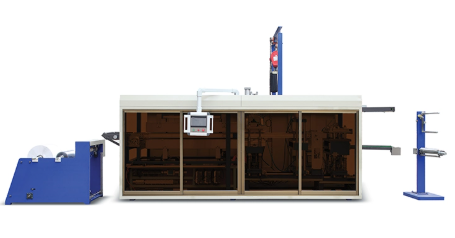Views: 0 Author: Site Editor Publish Time: 2025-09-27 Origin: Site
Looking for faster, precise production? A High Speed Thermoforming Machine can transform plastic sheets efficiently. Choosing the right machine boosts output and quality. In this article, you will learn how to select the best machine. We cover types, performance factors, and key applications.
High-speed machines operate at rapid cycle times, often producing hundreds of units per hour. They combine automated feeding, heating, forming, and trimming to reduce manual intervention.
Key Metrics:
Cycle time per part
Output per hour
Automation level
Heating Unit: Quickly warms sheets to the proper forming temperature.
Mold Assembly: Shapes sheets with precision and consistency.
Vacuum/Pressure System: Controls sheet forming.
Control Panel: Monitors temperature, pressure, and speed.
These components directly affect machine speed, reliability, and part quality.
Multi-Station Machines: Produce multiple parts simultaneously. Ideal for high-volume businesses.
Negative Pressure (Vacuum) Machines: Best for shallow or thin-walled parts.
Positive Pressure Machines: Form deep-draw, thick-walled parts with uniformity.
Lid/Cap Forming Machines: Specially designed for packaging closures.

High-volume production needs multi-station machines. Smaller operations may use semi-automatic units. Estimate daily output before selecting a machine.
Common materials include:
PET: High clarity, food safe
PP: Heat resistant, chemical resistant
PVC: Water and impact resistant
PC: Rigid, strong
Consider sheet thickness, flexibility, and heat sensitivity.
Shallow trays require vacuum forming. Deep, uniform parts need pressure forming. Complex molds may require fully automated machines.
Manual: Low cost, low speed
Semi-automatic: Balanced efficiency
Fully automatic: Minimal labor, highest throughput
Uniform wall thickness prevents defects. Accurate molds reduce waste. Regular monitoring ensures consistency.
High-speed machines can output 20–200 parts per minute. Cycle time impacts profitability and lead time.
Machines that optimize heating and forming reduce electricity use. Evaluate long-term operating costs, not just purchase price.
Stainless steel frames last longer and resist corrosion. Easy-to-access components simplify maintenance.
Tips: Preventive maintenance increases uptime and protects investment.
Trays, lids, and containers for food safety. Machines must maintain hygiene standards.
Covers for instruments and trays for drugs. Thin, high-precision sheets are common.
Panels, casings, and dashboards. Machines must handle durable plastics and complex shapes.
Seedling trays and plastic housings. Materials must resist UV and chemicals.
Tips: Match machine type to industry needs to maximize ROI.
| Feature | Vacuum Forming | Pressure Forming |
|---|---|---|
| Ideal Part Depth | Shallow | Deep |
| Wall Thickness Uniformity | Moderate | High |
| Speed | Moderate | High |
| Material Flexibility | Moderate | High |
Multi-station units produce multiple parts simultaneously. Single-station machines are simpler but slower.
Higher automation increases upfront cost but lowers labor and reduces waste. Balance budget with production needs.
Tips: Use ROI calculation to justify high-speed investments.
Choose manufacturers with proven success in packaging or your industry.
Proper training ensures operators maximize machine capabilities.
Machines with readily available parts minimize downtime.
Strong warranty coverage reduces risk and protects investment. Always verify references and past performance before purchasing.
Pre-set molds and materials to reduce downtime. Standardize common settings.
Check temperature, pressure, and cycle speed daily. Adjust for consistent quality.
Schedule regular inspections of heating, vacuum, and mold components.
Use sensors and automated monitoring to track output and detect errors early. Small adjustments can prevent costly scrap and delays.
Choosing the best High Speed Thermoforming Machine balances production, material, and design needs.
MINGDU offers reliable machines with precise automation and high throughput. Their equipment improves efficiency, reduces waste, and ensures quality packaging for businesses.
A: It is a machine that quickly shapes plastic sheets into precise forms, ideal for high-volume production.
A: Consider production volume, material compatibility, automation, and mold complexity to select the right machine.
A: It boosts efficiency, reduces waste, and ensures consistent product quality for packaging operations.